Your Complete Guide to Hair Transplant at UnitedCare
From pre-op consultation to post-op examinations, we will be united.
What are the problems we aim to solve?
Every month, thousands of hair transplantation surgeries are conducted in Turkey. However, 99% of them are done without doctor involvement or supervision.
In addition, many clinics still use outdated methods and do not update their techniques regularly concerning new research in the field since they don’t have a specialist like a dermatologist. The method significantly affects the outcome of the hair restoration process surgery.
Another problem is integrity and transparency. Some clinics quote differently, and people acquire the same service for different prices. Sometimes, patients are informed with false, wrong counts or overharvested to be charged more. In addition, some clinics keep the base price very low (like 1000 euros) and charge for every critical technique and medication (E.g. dermojet usage, vitamins, pills, sapphire tips, etc.).
Furthermore, the promised service might not be delivered; there might not be a surgeon, and a technician may lead the surgery. Even minor complications may lead to a hair transplant failure.
What does UnitedCare do differently?
Over 19 years of combined experience with dermatologists Mr. and Mrs. Kiziltac, our objective is to offer our patients the best possible treatment in line with their wishes.
How do we offer the best service at UnitedCare Clinic?
The Surgeon in the Operation – 1 Patient a Day
The dermatologist surgeon will be with you throughout the operation and personally perform crucial surgical procedures requiring cuts on the body.
Since the surgeon is performing and supervising the surgery, we only accept 1 patient a day.
Long Term Collaboration and Success
A dermatologist will always accompany you from the first contact to getting the final results after 18 months post-op. Your scalp will be ready for perfect hair transplantation with pre-op instructions, and we will closely follow healing progress.
High-quality and expensive aftercare sprays and other medications are provided and included in packages.
Cutting-Edge Techniques
We always follow the latest advancements and use cutting-edge techniques in hair restoration. Our latest addition concerning this philosophy is bio-enhanced hair restoration.
Without bio-enhancements, around 10% of grafts may die even after a flawless surgery.
Bio-enhancements provide grafts the best medium for survival, recovery, and growth.
At UnitedCare, we achieve outstanding results thanks to bio-enhanced hair restoration techniques.
Without further ado, let’s go into the details of each stage of the hair restoration journey.
UnitedCare™ Standards
⭐ One Patient a Day
⭐ 21+ years of combined experience
⭐ Dermatosurgeon
⭐ Professional 3D Digital Planning
⭐ ISHRS Associate, World FUE Institute and European Academy of Dermatology Member
⭐ Special DHI/Sapphire FUE Combination Surgeries
⭐ Bio-Enhancements: The highest graft survival rate with organ transplant solutions (Custodiol, hypoth.), PRP.

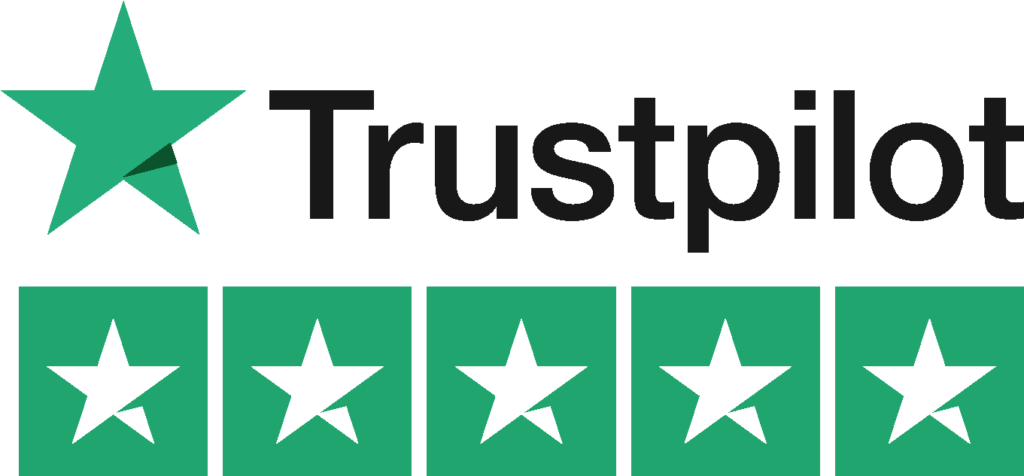
Step by Step Process
First Contact
A hair transplant candidate gets in touch with us through the consultation page, either filling out the form or directly texting us via WhatsApp.
The sales specialist contacts the patient, learns his/her condition, and asks for photos. Getting photos in line with the photo-taking guideline is crucial for a dermatologist to prepare a good and accurate diagnosis. So, patients are advised to follow the guideline.
The dermatologist examines your skin and hair condition and then prepares a hair transplantation diagnosis. Some patients are not eligible for hair transplantation, which is indicated in the file.
If the patient is suitable for the hair transplant, the patient moves on to the reservation stage.
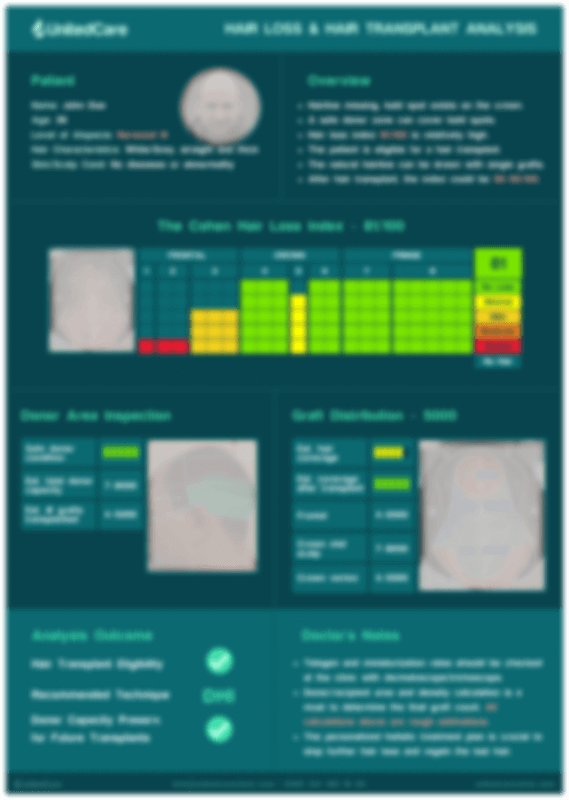
Reservation
The patient chooses the surgery date among available dates. Since we accept 1 patient a day, the next month’s schedules are generally tight in busy seasons.
The reservation is approved when the patient buys the ticket and shares it with the specialist. Therefore the patient is advised to buy the ticket as soon as possible upon determination of the surgery date for reservation confirmation.
Preoperative Preparation
Our customer success specialist unites with you to make sure you are very well prepared for the operation.
Starting from the pre-op 14 days, the patient gets instructions via Whatsapp or email.
Pre-op instructions make your scalp and hair follicles healthier and stronger and directly contribute to the final result.
To make our patients follow crucial pre-and post-op instructions easily, we have created the application: Care Assistant.
The patient enters the surgery day once (the app auto-saves it) and sees the customized instructions. To learn how to use the app, you can watch the “How to use Care Assistant” video on the same page.
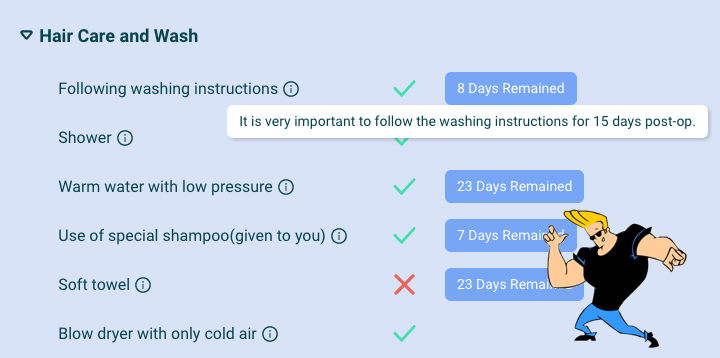
Arrival to Istanbul
From the minute you arrive in Istanbul until you leave, all of your transfers are with the Mercedes VIP Van for your comfort and safety.
The chauffeur welcomes you at the main exit holding a sign with your name and leads to the vehicle.
All chauffeurs are licensed with years of experience in megacity traffic.
During your time in Istanbul, the patient never feels alone. The specialist is always at the end of the line answering your questions and making sure everything goes according to the plan.

Hotel
Before and after the operation, the hotel plays a vital role in your comfort and peace of mind.
You can enjoy the safe, relaxing, and comfortable environments of internationally recognized 5-star hotels.
We provide you with an additional day in the hotel to rest and relax after the operation.
You can bring an additional person to stay in the same hotel room; no extra charge. Keep in mind that we provide state-of-the-art dermocosmetic treatments such as filler, botox, non-surgical nose jobs, and many more.
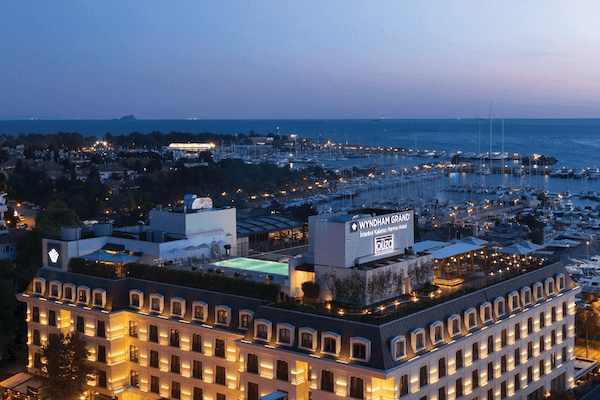
Operation Day
The chauffeur gets the patient from the hotel and brings him/her to the hospital for the 6-10 hours of hair restoration operation.
The surgeon waits for the patient at the hospital for pre-op examination.
Pre-Op Examination
In the morning, the driver takes the patient to the clinic.
In the meeting with the doctor in the pre-op consultation, the patient expresses his/her wishes and expectations.
The doctor examines the hair and scalp condition and asks questions to get more information about your family genetics, medical history, habits, and lifestyle for personalized treatment.
With the dermatoscope, tricoscopic examination is done to get telogen and miniaturization rates. This check gives a clear idea about donor hair quality and amount.
We just don’t plan to cover bald spots on the scalp but:
- Determine the severity of Androgenic Alopecia
- Figure out how AGA would advance
- Identifying high-risk balding zones in the next 2-3 years.
- Cosmetic appearance with respect to head shape
Only an experienced dermatologist surgeon can do this kind of long-term planning.
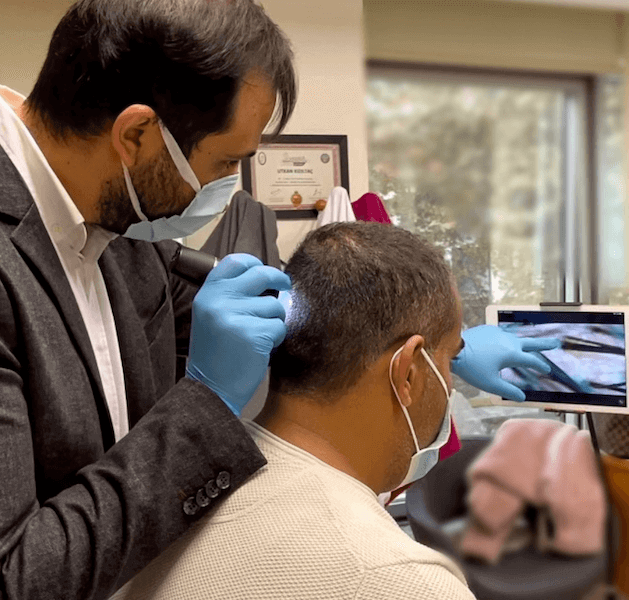
The doctor makes the required calculations for optimum coverage. A precise number of grafts planned to be transplanted is determined at this point. We don’t overharvest or deplete your donor area but provide you with the best coverage possible.
In the calculation, 360-degree scanning system is used.
It assesses a patient’s head and hair and outputs 3-D scalp modeling and some crucial data including:
- Each hair’s shaft diameter and caliber
- Hair density in donor area
- The total donor capacity
- The coverage value
- The number of grafts extracted in previous hair transplant surgeries.
So your precious and limited donor hairs are used wisely to cover your bald or thinning zones.
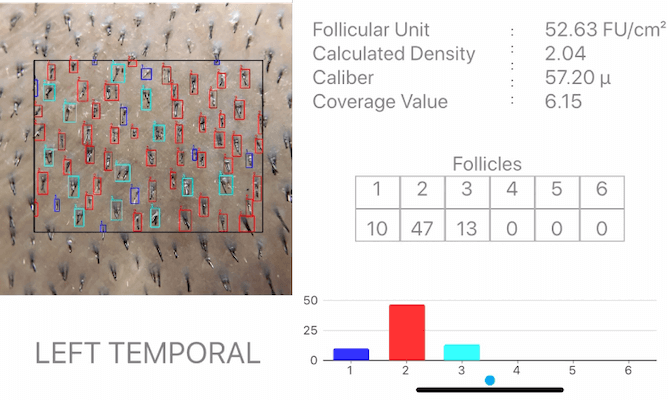
An average person has 120-200 hairs per square cm2, and generally, 1 root has more than a single hair. Therefore, there is no direct relationship between graft count and hair density.
Then, the patient is informed about your scalp condition, hair quality and density, and your donor/recipient areas. As a result of this step, the patient is advised of
- The unique hair density and quality
- The proper integrated treatment
- Expected results and operational forecast
Drawing the Perfect Hairline
The doctor will draw the hairline using a laser-assisted hairline device to set the perfect symmetry between the left and right sides.
Your wishes and surgeons’ artistic abilities will define the desired hairline, considering:
- Forehead muscles
- Face and Bone Structure
- Ethnicity
- Age
- Balding Severity
- Donor Capacity
When the patient approves the hairline, the team moves on to the next step.
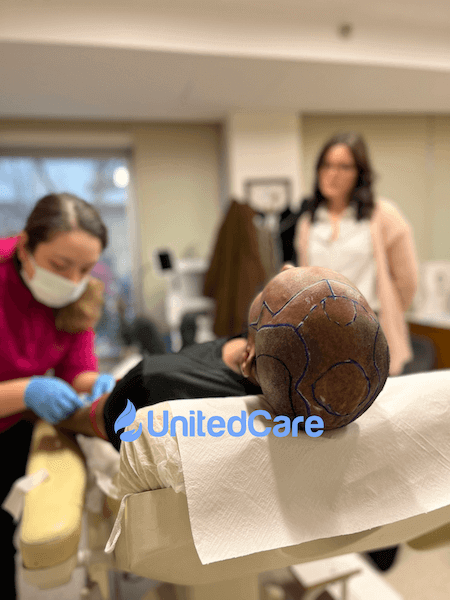
Execution
You are accompanied to the operation room, and the team assists you in settling on the surgical chair.
Disinfection
The scalp is disinfected with Baticon to prevent any infection.
Hair cut / Unshaven Transplant
If the patient wants unshaven hair transplantation with Direct Hair Implantation (DHI) technique, hairs are not cut.
Otherwise, the patient gets his haircut.
Local Anesthesia / Sedation by Anesthesiologist
Standard needle-free Dermojet local anesthesia or sedation (by an anesthesiologist) is done concerning the patient’s choice.
The patient has a comfortable operation after the anesthesia starts to take effect. Some patients even sleep afterwards.
Follicle Extraction (2-3 hours)
The smallest possible motorized micro punch is used to release hair roots.
The key here is finding the smallest diameter punch, which gives minor damage to the donor area and results in the lowest transection rate.
Transection is the amputation of single or multiple hair follicles. Transection rate is % of follicles that are transected during the operation.
The rate depends on the experience of the operator. The least skilled one can have a transection rate between 20-50% meaning almost half of the precious and limited grafts are amputated.
Some clinics use bigger punches to extract grafts to reduce the transection rate without decreasing the surgery speed (speed is essential for “hair mill” clinics), extending the healing period, and leaving scars.
Our clinics’ transection rate is 1-2%, and we extract 98-99% of grafts without damaging them with the tiniest diameter motorized punches.
Also, homogeneous graft extraction is essential. Otherwise, the density in some parts won’t match other regions, and overharvesting may occur in some zones.
Picking the right hairs from the donor zone requires surgical knowledge and experience. The purpose is to ensure the same density of hair to achieve a natural look.
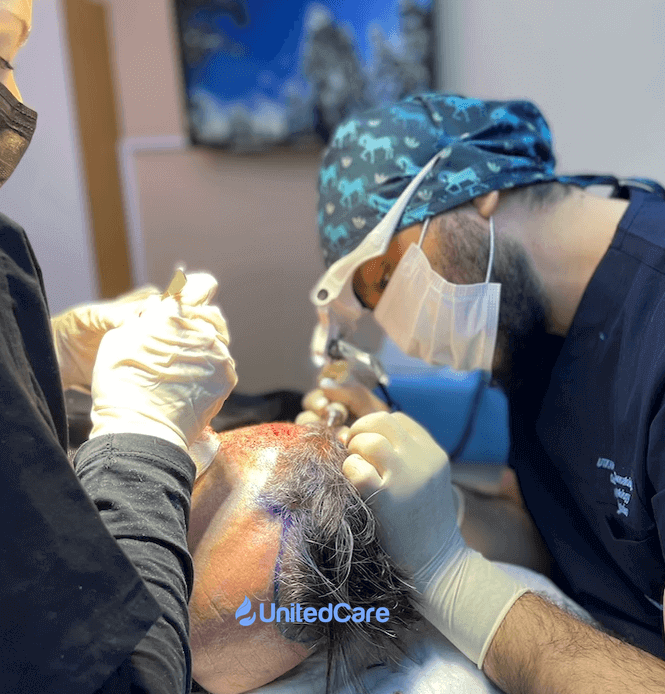
Graft Storage with Bio-Enhancements
Extracted follicles are placed in a petri dish.
In Petri dishes, special solutions called bio-enhancements are used to store grafts.
In a hair transplant, live hairs are taken out from the body and left without glucose and oxygen.
And they are exposed to external pressure forcing cells to use energy sources to counterbalance to remain intact.
Even if they are implanted very soon, they are not connected to blood vessels for days. So they are susceptible.
Most clinics make graft storage mistakes: They use extracellular storage solutions such as saline or ringer’s lactate and lower the temperature to 4°C, which puts a lot of pressure on live cells.
At UnitedCare, we use intracellular solutions helping cells stay alive for days outside the body. They increase graft survival rates significantly.
The mix we use to store grafts is the perfect combination of custodial, PRP, and some other solutions.
Grafts are classified based on hair strand counts to achieve the most natural result.
- Single hairs are used to draw the frontal hairline.
- Doubles and triples are implanted further back.
Lunch Break
After the graft extraction and storage phase, there is time for lunch. The patient is provided with the catered food of the hospital.
The patient is advised to tell any food allergies.
After lunch, the final implantation stage starts.
Implantation (2-4 hours)
This time, the local anesthesia is applied (if you haven’t chosen sedation by the anesthesiologist to recipient zones that are generally hairline and crown.
Extraction and graft storage phases are the same for Sapphire FUE and DHI. But their implantation stages are different.
Sapphire FUE
Compared to DHI, more grafts can be implanted with this technique.
In regular FUE, cheaper steel blades/scalpels are used to make incisions/cuts, which causes more tissue trauma. In Sapphire FUE, sapphire blades made from expensive gemstones are used. Sapphire blades are known for their sharpness, smoothness, and durability.
Therefore, the Sapphire tip causes fewer wounds in the incision stage (it is used to open micro-channels). Thus, it results in less trauma, swelling, bleeding, pain, and a faster recovery period and increases the likelihood of success compared to the regular FUE.
At UnitedCare, we don’t perform regular FUE.
The micro-incision stage is crucial and where expertise and experience come into play. The transplanted hairs’ angle, depth, and density depend on the incision quality.
The FUE technique is better for patients having severe baldness.
In a single session, up to 5000 grafts can be transplanted.
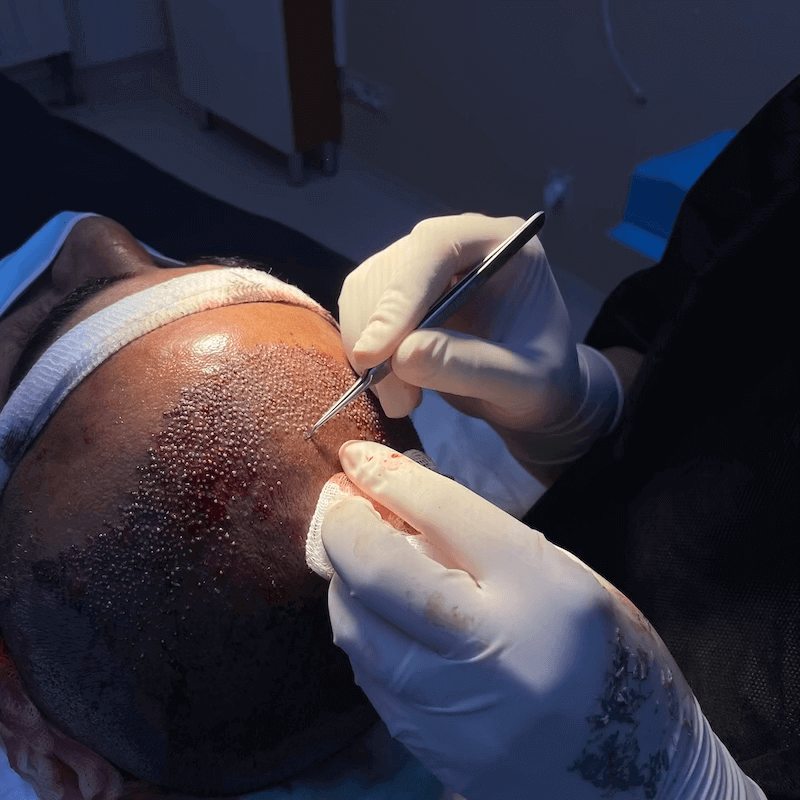
DHI (Direct Hair Implantation)
Direct Hair Implantation differs from FUE in the implantation stage. In this method, a special implanter pen is used to simultaneously open channels and implant grafts.
The operator can easily control the implant’s angle, direction, and depth using the special pen.
Increased precision makes this technique appealing, even if it is more expensive than FUE.
In addition, the DHI technique has a faster recovery period and can be performed with less bleeding than the FUE method.
However, it is a more advanced technique and requires more experience.
Up to 3500 grafts can be transplanted in a single session since the surgeon does all graft placements.
Some clinics assert that they can transplant hairs with DHI as much as with FUE.
If any clinics say so, it means 2 or more technicians implant grafts to different areas with different DHI pens simultaneously, which is quite dangerous since the patient has 2 different implant styles, resulting in an unnatural look. The eye can easily detect this difference at first glance.
In addition, unshaven hair transplantation is easier with DHI, and better density can be achieved without harming existing hairs.
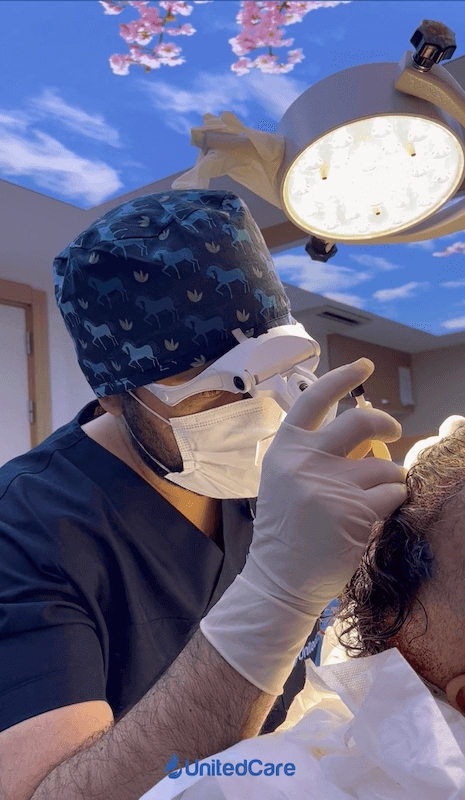
PRP Injections
Utilizing the power of your blood is crucial for the success of the restoration surgery.
Besides being used in graft storage solutions, Platelet Rich Plasma (PRP) is injected right after hair transplant operation to make your hair thicker, stronger, and healthier.
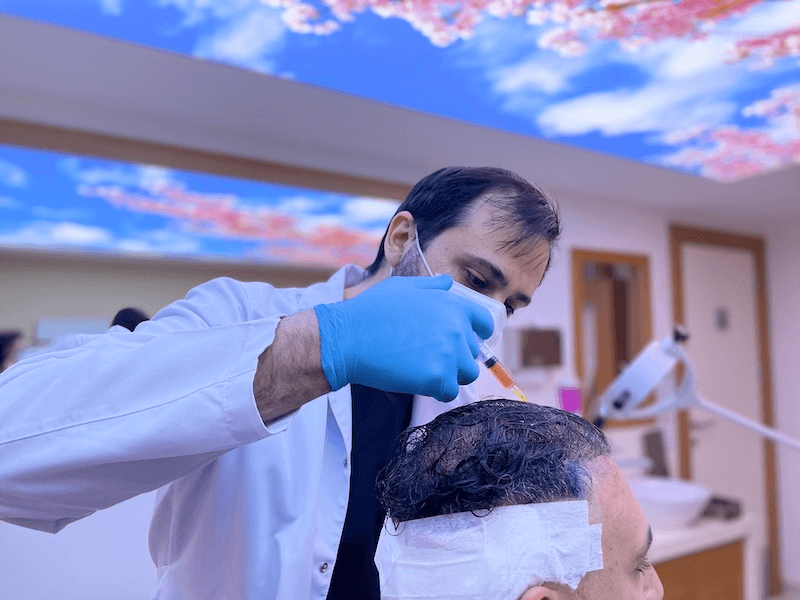
Post-op Meeting
The necessary dressing is done. The donor area is covered with a gauze bandage with an antibiotic cream.
Then, the surgeon explains surgery details, graft count, coverage, etc.
Crucial post-op instructions are described to the patient; what to pay attention to, how to sleep, medication usage, etc.
Grafts are susceptible at this point and need good care.
The patient is provided with a box containing shampoos, post-op spray, and medications.
The Day After the Surgery
The patient is brought to the clinic with VIP transfer again.
The operation team removes the patient’s bandages, and the surgeon examines the donor and recipient zones.
Then, the first hair wash is done carefully under the doctor’s supervision.
Finally, the patient leaves the clinic and has a chance to enjoy Istanbul.
Airport Transfer and Departure
After the rest day, The patient is transported to the airport to fly home.
Post-op Checks
After 1st, 3rd, 6th, 9th, 12th, and 18th months, the specialist will reach you to check your healing progress. Photos are asked, and the surgeon reviews them.
The patient becomes a member of the UnitedCare family and can always reach us to ask anything he/she wants.
This is UnitedCare’s hair restoration process from A to Z. If you like to ask anything about procedures, feel free to reach us through the consultation page.
See you in Istanbul!

Every detail in the hair transplant process matters.
Get a consultation from a dermatologist surgeon who is obsessed with details.